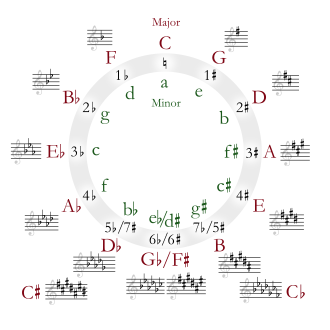E minor
 From Wikipedia - Reading time: 6 min
From Wikipedia - Reading time: 6 min
| Relative key | G major |
|---|---|
| Parallel key | E major |
| Dominant key | B minor |
| Subdominant key | A minor |
| Component pitches | |
| E, F♯, G, A, B, C, D | |
E minor is a minor scale based on E, consisting of the pitches E, F♯, G, A, B, C, and D. Its key signature has one sharp, on the F. Its relative major is G major and its parallel major is E major.[1]
The E natural minor scale is:

Changes needed for the melodic and harmonic versions of the scale are written in with accidentals as necessary. The E harmonic minor and melodic minor scales are:


Much of the classical guitar repertoire is in E minor, as this is a very natural key for the instrument. In standard tuning (E A D G B E), four of the instrument's six open (unfretted) strings are part of the tonic chord. The key of E minor is also popular in heavy metal music, as its tonic is the lowest note on a standard-tuned guitar.
Scale degree chords
[edit]The scale degree chords of E minor are:
- Tonic – E minor
- Supertonic – F-sharp diminished
- Mediant – G major
- Subdominant – A minor
- Dominant – B minor
- Submediant – C major
- Subtonic – D major
Notable compositions
[edit]- Charles-Valentin Alkan
- Le festin d'Ésope, Op. 39, No. 12, from 12 etudes in all the minor keys
- Johann Sebastian Bach
- Ludwig van Beethoven
- Johannes Brahms
- Symphony No. 4
- Cello Sonata No. 1
- Fantasies, Op. 116 (5th movement)
- Four Pieces for Piano, Op. 119 (2nd movement)
- Frédéric Chopin
- Franz Danzi
- Gaetano Donizetti
- String Quartet No. 18
- Antonín Dvořák
- Symphony No. 9 (From the New World)[2]
- Piano Trio Op. 90
- String Quartet No. 4
- Slavonic Dance No. 2, Op. 46
- Slavonic Dance No. 2, Op. 72
- Edward Elgar
- Louise Farrenc
- Piano Trio in E minor, Op. 45
- Edvard Grieg
- George Frideric Handel
- Messiah (overture)
- Joseph Haydn
- Symphony No. 44 (Trauer)
- Ignaz Holzbauer
- Flute Concerto in E minor
- Margaret Ruthven Lang
- Rhapsody in E minor, Op. 24
- Karol Lipiński
- Violin Concerto No. 3, Op. 24
- Franz Liszt
- Malédiction, S. 121
- Felix Mendelssohn
- Preludes and Fugues, Op. 35 (first pair)
- Violin Concerto
- String Symphony No. 3 in E minor, MWV N 3
- String Quartet in E minor, Op. 44
- Fugue in E minor, MWV W24
- Albumblatt, Op. 117
- Franz Xaver Wolfgang Mozart
- Rondo for Flute and Piano
- Wolfgang Amadeus Mozart
- Pietro Nardini
- Sonata No. 6 for two violins and bass
- Niccolò Paganini
- Sergei Prokofiev
- Franz Schubert
- Piano Sonata in E minor, D. 566
- Piano Sonata in E minor, D. 769A
- Fugue in E minor for four hands, D. 952
- Dmitri Shostakovich
- Jean Sibelius
- Symphony No. 1, Op. 39
- Bedřich Smetana
- Sergei Rachmaninoff
- Moments musicaux, Op. 16, No. 4
- Symphony No. 2
- Vocalise, Op. 34, No. 14
- Maurice Ravel
- Franz Xaver Richter
- Flute Concerto in E minor
- Nikolai Rimsky-Korsakov
- Pyotr Ilyich Tchaikovsky
- Carl Maria von Weber
- Piano Sonata No. 4 in E minor, Op. 70
- Ralph Vaughan Williams
- Giuseppe Verdi
- Carl Maria von Weber
See also
[edit]References
[edit]- ^ "Notation" BBC Bitesize. Retrieved 2023-06-14.
- ^ "Symphony No. 9 in E minor, 'From the New World’ – Largo by Antonín Dvořák" BBC. Retrieved 2023-06-14.
External links
[edit] Media related to E minor at Wikimedia Commons
Media related to E minor at Wikimedia Commons
 KSF
KSF
